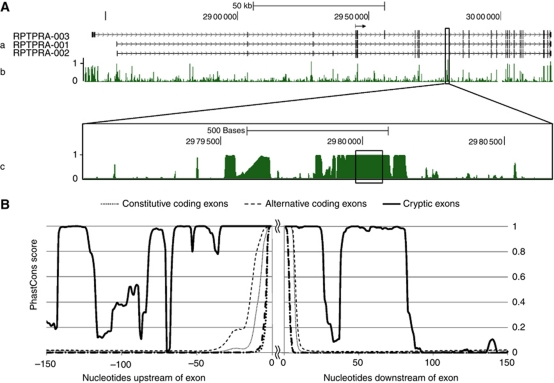Figure 7.
Extreme conservation of cx95, the 95-nt cryptic exon in RPTPα245, and its flanking region in placental mammals. (A) Evolutionary conservation in the RPTPα-coding region. (a) The locations of the exons in the three predominant RPTPα transcripts (Vega PTPRA-001, -002, -003) relative to the human genomic sequence (assembly GRCh37/hg19, February, 2009) as shown on the UCSC Genome Browser (Kent et al, 2002) are indicated by vertical bars on the three corresponding horizontal lines. (Numbers correspond to chromosome 20 locations.) The coding region begins at the position indicted by the horizontal arrow at 2 944 924. (b) The probability that each nucleotide is located within a region that is evolutionarily conserved within 33 placental mammals (computed by the hidden Markov model phastCons algorithm (Siepel et al, 2005) using the vertebrate Multiz alignment (Blanchette et al, 2004)) is displayed as shown in the UCSC Genome Browser. The boxed region surrounds the 95-nt cryptic exon incorporated into the RPTPα245 mRNA. (c) The boxed region from (b) is expanded and the 95-nt cryptic exon is boxed. (B) Evolutionary conservation in the cx95 flanking regions. Placental mammal PhastCons conservation probabilities were computed for the nucleotides flanking cx95, 32 572 human alternative coding exons, and 171 060 human constitutive coding exons. The solid line displays the probabilities in the regions flanking cx95, the heavy dashed (dotted) line displays the median probabilities in the regions flanking the alternative (constitutive) coding exons, and the light dashed (dotted) lines display the upper third quartile limits of the probabilities for the alternative (constitutive) coding sequences. (The heavy dotted line displaying median probabilities for the constitutive coding exons is mostly obscured.)

